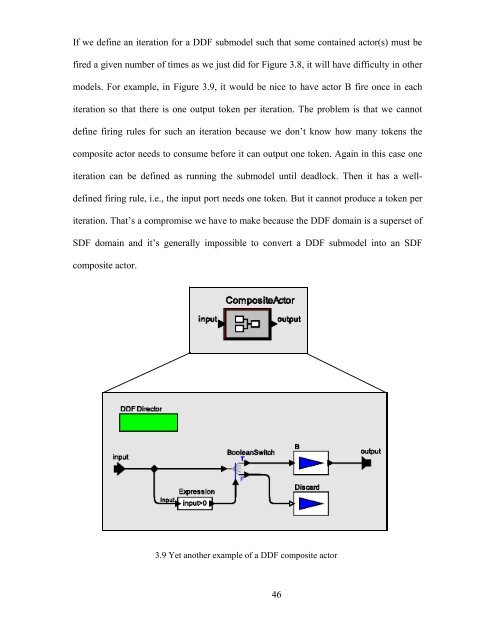Dynamic Dataflow Modeling in Ptolemy II - Ptolemy Project ...
Dynamic Dataflow Modeling in Ptolemy II - Ptolemy Project ...
Dynamic Dataflow Modeling in Ptolemy II - Ptolemy Project ...
Create successful ePaper yourself
Turn your PDF publications into a flip-book with our unique Google optimized e-Paper software.
If we def<strong>in</strong>e an iteration for a DDF submodel such that some conta<strong>in</strong>ed actor(s) must be<br />
fired a given number of times as we just did for Figure 3.8, it will have difficulty <strong>in</strong> other<br />
models. For example, <strong>in</strong> Figure 3.9, it would be nice to have actor B fire once <strong>in</strong> each<br />
iteration so that there is one output token per iteration. The problem is that we cannot<br />
def<strong>in</strong>e fir<strong>in</strong>g rules for such an iteration because we don’t know how many tokens the<br />
composite actor needs to consume before it can output one token. Aga<strong>in</strong> <strong>in</strong> this case one<br />
iteration can be def<strong>in</strong>ed as runn<strong>in</strong>g the submodel until deadlock. Then it has a well-<br />
def<strong>in</strong>ed fir<strong>in</strong>g rule, i.e., the <strong>in</strong>put port needs one token. But it cannot produce a token per<br />
iteration. That’s a compromise we have to make because the DDF doma<strong>in</strong> is a superset of<br />
SDF doma<strong>in</strong> and it’s generally impossible to convert a DDF submodel <strong>in</strong>to an SDF<br />
composite actor.<br />
3.9 Yet another example of a DDF composite actor<br />
46
















